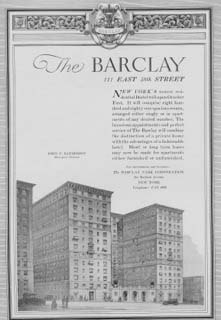Attention! Connoisseurs of luxe living, those who
wish they were, history aficionados and name
droppers: Here is a book for you.
“The Barclay Hotel,” is another fascinating story
about a hotel by Ward Morehouse III, this time with
a co-author, social and cultural historian Cindy
Gueli.

This is no mere description of the hotel’s
amenities, but rather an account of the role it
played in social history, which reflected the
fortunes of New York City.
The authors present the Barclay in the context of
the other lavish hostelries in its neighborhood and
of the events that
shaped it.
In the age of opulence it chose graciousness over
glitter, privacy over public preening.
The 14-story residential hotel opened in 1926,
the last of the four “terminal hotels,” which
connected to Grand Central Station. The others were the
Commodore, the Roosevelt and the Biltmore—all
reflecting the great age of railroads.
When building Fifth Ave. marble palaces became
passé, a badge of status became living in a hotel,
something with which author Ward Morehouse III is
well aware, having grown up in such accommodations.
The list of “names” who resided at the Barclay is a
virtual Who’s Who of the last
90 years. The book takes note of the other railway
hotels as well as Barclay neighbors— Katharine
Hepburn, Georgia O’Keeffe, Alfred Stieglitz among
them.
The book is chock full of anecdotes that make for fascinating dinner
conversation. Who knew that Jack Dempsey was a
devotee of The New York Times? Or that Perle Mesta
had wanted to be an opera singer and came to be the
hostess with the mostess to Metropolitan Opera stars
from Rosa Ponselle to Ezio Pinza!
Earnest
Hemingway’s work and carousing are hilariously
reported. At the other end of the social spectrum
are Henry Cabot Lodge,
Jr. and
a legion of Vanderbilts.
(A genealogy chart would be helpful.)
There’s a particularly interesting section on
Caswell-Massey, much more than “chemists to the
stars.” The apothecary opened in 1752 and claimed
George Washington as a customer. Its space in the
Barclay included a soda fountain where at various
time could be found Judy Garland, Helen Hayes, Anita
Loos, Lawrence Olivier, and legendary aviatrix
Amelia Earhart.
A regular Caswell-Massey customer
was Greta Garbo, who kept buying tortoise-shell
combs.
The Barclay Hotel provided tasteful elegance, a
classic oasis away from the madding crowds. The
Cornell Club occupied the third floor for decades
and was provided a separate entrance away from the
main doors.
A Barclay ad from the 1970’s says:
“New York is breakfast with your banker, dinner with
your lawyers and trying to keep a hundred securities
analysts from having you for lunch.”
The Barclay was sold and resold, at one point
becoming the flagship for the InterContinental
chain, but as of 2001 was again named the Barclay.
Although surrounded by glittering skyscrapers, the
Barclay remained true to its roots offering Old
World elegance and warmth.
The reviewer, Beatrice Williams-Rude, is the author
of “Misadventures of a Would-Be Muse,” a mostly
mirthful memoir of her days in the theater.